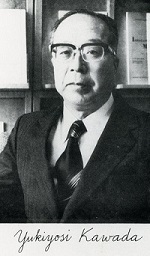 The website is in construction. New files will be uploaded as soon as they are available.
The website is in construction. New files will be uploaded as soon as they are available.
YUKIYOSI KAWADA
Tokyo 1916 – Tokyo 1993

Brief scientific biography
Yukiyosi Kawada was born in Tokyo on 15 January 1916. Graduated from Tokyo High-school in 1935, he entered (Imperial) University of Tokyo, where he studied number theory, especially class field theory under Professor Zyoiti Suetuna. There he met Shokichi Iyanaga, who was an assistant for Professor Teiji Takagi.

In 1972, Kawada (left) and Iyanaga (right) at the Institute of Statistical Mathematics.
In 1938, graduated from the University of Tokyo, he spent several years as assistant at the University of Tokyo and as associate professor at Tokyo Bunri University. In 1950, he became a professor at the University of Tokyo and taught there for 26 years.
At the same time, between 1971-73, he was the director of the Institute of Statistical Mathematics. Between 1967-69, he was a member of Evaluating Committee of Mathematics textbooks, nominated by the Ministry of Education. Between 1973-81, he was a supervisor of mathematical education nominated by the Ministry of Education. He was elected as a president of Mathematical Society of Japan.
In 1976, at the age of 60 he retired from the University of Tokyo. Then from 1976 to 1986, he taught mathematics as a professor at Sophia University in Tokyo.
Between 1970-74, he was a member of Executive Committee of International Mathematical Union and between 1974-78, a member of Consultative Committee of the International Congress of Mathematicians held in 1978 at Helsinki.

As a mathematician, he covered several fields of mathematics including algebraic functions, group theory, probability, operator rings, cohomology theory, topological groups, class field theory, infinite extension of fields, analytic line bundles, class formations, and theory of cosheaves. His research papers in mathematics are written in German or English. The number of them exceeds 59. His main theme in mathematics is the theory of class formations related to the theory of class fields. There are six papers related to class formations. The first one was published in Duke Mathematical Journal, 22 (1955), 165-177.
Komaravolu S. Chandrasekharan, who was a secretary of the International Mathematical Union (IMU), stated that “he (Kawada) was as quiet as he was efficient and it was a joy to be with him.”
Selected works
Y. KAWADA, K. ITO 1940, On the probability distributions on a compact group, I, In Proceedings Phys.-Math. Society Japan ser. 3, 22, 977-998.
Y. KAWADA 1953, On the ramification theory of infinite algebraic extensions, Annals of Mathematics, 58, 24-47.
Y. KAWADA, J. TATE 1955, On the Galois cohomology of unramified extensions of function fields in one variable, American Journal of Mathematics, 77, 197-217.
Y. KAWADA 1955, Class formations, Duke Mathematical Journal, 22,165-178.
Y. KAWADA 1975, Commission Internationale de l’Enseignement Mathématique. Information for the period 1975-1978, L’Enseignement Mathématique, s. 2, 21, 331-335.
S. IYANAGA, Y. KAWADA, (Eds.) 1977, Encyclopedic Dictionary of Mathematics, 2nd ed.; English translation reviewed by K. O. May (by Mathematical Society of Japan with the cooperation of the American Mathematical Society), Cambridge MA/ London, MIT Press. Two volumes. Reviewed by J. Dieudonné, American Mathematical Monthly, 1979, 86, 232-233.
Author
Shigeru Iitaka
Gakushuin University, Japan
851051@gakushuin.ac.jp
